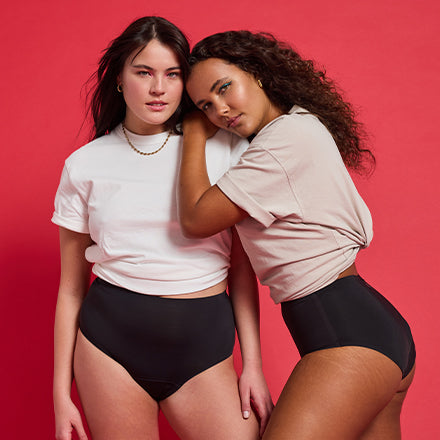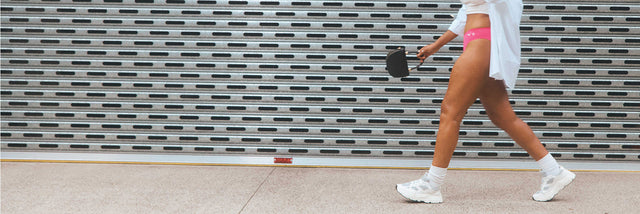We asked our in-house Doctor, Jana Pittman to give us the run down on the different types of incontinence, the causes, her personal experiences after 6 children, and management techniques.
How common is incontinence?
Urinary incontinence effects 1 in 4 women but as we age it reaches around 75% of women (over 65years). It is something we all really need to know about and talk about!!
Why is more common in females than men?
It is fairly common in both men and women but yes research shows more women are prone to leakage than men due to life events like pregnancy, childbirth, hysterectomy, and menopause which can the female pelvic floor muscle structure.
What are the different types?
There are two main types of urine incontinence, stress incontinence and urge incontinence although many people have a combination of both which is called mixed incontinence.
Urge incontinence is the inability to prevent leakage due to the sudden urge to void without delay. This type of incontinence usually is caused increased bladder pressure and tension (cant hold urine at normal pressures). The bladder tends to contract too much and this pressure initiates premature voiding. Stress incontinence is urine leakage occurring due to ‘bladder stress’. For example in physical activities, such as coughing, laughing, sneezing, jumping or even walking.
What are the causes?
There are many causes for incontinence and its not only women who have given birth!! Pregnancy and childbirth stretch the pelvic floor which can lead to muscle weakness and prolapse but even menopause is a common cause as the vagina and urethra become dry and thin. Being overweight, smoking, constipation and certain medications and urinary tract infections can also lead to incontinence. There are also conditions like multiple sclerosis and diabetes that are known to be related with increased rates of urinary leakage.
Is it curable? What are the treatments and management techniques:
Many of the causes of incontinence can be managed with either improving the muscles, internal pessaries or wearing leak proof underwear or pads. When you come to see a doctor the first thing they will talk about is intake-output and whether there are certain drinks like caffeine, alcohol and soft-drinks which might be contributing to the incontinence (and are easily removed). Then you will be asked to keen a bladder diary to work out when its problematic and if it’s associated to drinking, a full bladder or stress on the pelvic floor. Most commonly, doctors start with sending you to a physiotherapist that specialises in pelvic floor rehabilitation but there are online programs you can do at home to strengthen these muscles. Just like other muscles they need to be trained and, in the meantime, invest in some good leakage underwear like Modibodi’s.
Depending on the type or cause of your incontinence, there are internal devices called intravaginal pessaries and medications (bladder relaxants) that can be considered and even surgery (ie midurethral sling) but it’s definitely best to exhaust the non-invasive options first.
Any tips for someone who has just become incontinent?
The best tip for me is don’t be embarrassed.. talk to your family doctor or get a referral to a specialist who can start you on the processes to recovery. In the meantime get some Modibodi undies!
Why do you think it's such a taboo topic?
Its only taboo because we don’t talk about it… so let’s change that!! We all have had accidents in our life and it’s time to break the silence. Yes it involves are groins and that is the main reason people feel discomfort talking about it, similar to anything that involves the vagina or penis but the more we talk about it the more a loved one is likely to seek help.
What do you find is the biggest roadblock for women not getting treated for incontinence?
Embarrassment, especially younger women who don’t realise they aren’t alone and that it is quite common. It is hard to admit you are wetting yourself, which is one of the reasons I decided to admit it on national TV during my SASAustralia show, as we need to be brave and seek help.
How can we help break down the stigma for incontinence?
We need to talk about it unashamedly!! Get help yourself, see a women’s health physio or doctor. Then share your story!! the more we normalise the issue, the more women will seek help. Use products like Modibodi to share the message, discuss what works for you with others!
Did you notice more incontinence after twins?
Yes, more frequent incontinence and from earlier in the pregnancy. The weight of the babies sits on your bladder but also the heaviness of the overall pregnancy messed with my pelvic floor tone. Another issues I had was at times I couldn’t feel that my bladder was full, I had no urge to go, so I had to use the bathroom more frequently and just ‘try’ as if I didn’t do this, the stress of a sneeze or running upstairs at the hospital could often leave me squeezing my legs together. I wore my Modibodi undies all the time!!
What was the recovery after twins like?
The recovery was definitely a little longer but I think this was also because I have had 6 kids and the last 3 within 2 years so my pelvic floor took some time to recover. After the birth of the twins, I was totally incontinent for 2 weeks, literally couldn’t hold my urine, this had not happened before. I also had a lot more residual tummy this time too as I had stretched a lot to accommodate two babies. So yes, Modibodi undies were an absolute must. Initially the first few days after birth with a pad due to the very heavy bleeding so I didn’t have to worry about overflow, but soon just the high waisted Modibodi pants were perfect for both urine and the blood.
Our best product for incontinence is our Sensual High-Waist Brief Ultra Incontinence Absorbency.
A classic design with full coverage and reliable protection, the Sensual Hi-Waist Brief is our most absorbent style ever - holding up to 250mls. Designed to manage incontinence discreetly, comfortably and without leaks or odour, this style looks and feels like everyday underwear but with a built-in floating leak-proof lining which completely replaces disposable incontinence pads or underwear...and always feels dry.
See Jana discussing Ultra here:









